Genre: Shmup Developer: Sega Enterprises Publisher: Sega Enterprises Players: 1-2 Released: 1992
Remarkable to the arguably oversaturated library of horizontal shmups the Genesis is rich, is that this title is Sega’s only release entirely produced themselves in this subgenre, at the time. While other horizontal shmups for the Genesis seem accredited to Sega, all were realized by other companies. No, Thunder Force is unmistakably TechnoSoft’s creation and Super Fantasy Zone is made by SunSoft. Perhaps they were too busy porting their Space Harriers and Afterburners.
Sega’s only side scrolling shooter looks to separate itself from the standard shooters though. Gone are the pumping tunes seemingly staple for the genre, and substituted by dark bass tones, unsettling melodies, and outlandish rhythms. The departure is further accentuated by the freakish creatures that appear on-screen, your ship perhaps being the prime example. Instead of sending in the popular metal fighter into the mayhem your protagonist is one of four alien looking organic “bio-ships.”
The precedence to all this is that during a Biowar on the planet of Avaron the enemy unleashed a lethal virus, transforming the planet into a living place for new hostile creatures. Survivors flee to a spaceship circling the orbit of the planet. After centuries of cryogenic sleep, these survivors are awakened with the message that the planet’s conditions are still hazardous, but inhabitable. It’s up to you to make the planet safe for colonization. Any excuse for wreaking a lot of havoc.
The game provides challenge with five difficulties and amount of lives to start out with. Once set to your liking, you, with an optional friend, can choose between the four aforementioned bioships, each varying in speed and array of weapons. Once you’ve picked your ‘ship’, the space station undocks your ship into the atmosphere, starting the first stage.
Your ship controls easy enough. While the A button fires your ship’s rapid fire, the B and C button load a strong charge shot. It would’ve been nice if they had assigned one of the charge shot button for speed control. Alas, you’re either fast or slow, depending on the ship you’ve chosen. Being able to collide with any surface is a welcome compromise though, sparing you some R-Typical frustration.
The crucial game play feature is your insect option that revolves opposite to your ship’s movements. From the get-go this little companion joins you to provide the critical firepower, even if it is just a measly twin shot at the beginning. It can be upgraded twice by picking up power-ups matching the colour assigned to the weapon. Picking up a differently coloured power-up merely changes it to another of the four weapons your ship possesses out of the seven available weapons in the game. An annoying quirk is that in a two player game your friend’s ship can unintentionally block your option shots, nullifying potentially crucial firepower.
If you’ve chosen the right ship, you’ll be toting the strongest homing laser soon. Yes, a homing laser, as there’s little need to wield another weapon. The homing laser is quite strong, efficient, and quick. There’s no use in explaining what qualities the other weapons possess, all pale with the relentless effectiveness of this laser. Sega would’ve invested well in balancing the weapon range.
That’s not to say the game becomes an easy run-through. Once you make it to the surface, the enemy count steadily ups and they’re becoming tougher as the game progresses, as well as increasingly more freaky. And the bosses follow suit. While the first boss in the second stage takes things easy, the boss in stage three quits joking around and proves himself a very unpredictable foe. The fish boss of stage five is widely regarded the most annoying pain in the behind this game provides. Better be on the lookout for hidden 1ups throughout the stages. Luckily you’ve got nine continues. Unfortunately, you’ll be starting the stage with a twin shot again once you do.
Speaking of stages, you’ll be blasting through surroundings like a ruined cityscape, a dark cave and an ocean bottom, among other. Although relatively sparse, the stages themselves provide added challenge with winding paths, twisting platforms and spewing outlets. Stage seven is inarguably the foremost showcase of this, having you creeping through tight corridors and braving junk spraying waste pipes.
All this and more considered, it’s still “ye olde” shooter. There’s little that hasn’t been done before, better planned: What few environmental challenges there are do little to deter you from your normal path. The game’s mechanics aren’t exactly novel either: the power-up system is very reminiscent of Raiden and the reverse revolving option feels inspired from Neo Geo’s Last Resort. The ones seeking a new experience in shooting will find little satisfaction in this title.
Bio-Hazard Battle‘s appeal is in its presentation. Backgrounds and creatures look convincingly post-apocalyptic and mutated, and while dark, they show a lot of colour and detail. It all feels a little plastic however, as if pre-rendered. Backgrounds mainly lack animation as opposed to the well animated sprites. Stage five is a visual triumph however, sporting moving water effects, interesting underwater life, and a profoundly interactive landscape.
Aurally, the game amplifies the otherworldly settings well. The bleeps and pops are convincingly alien to whatever event is triggered, albeit most are a bit mute. The music is downright creepy and weird. While nothing award winning, the haunting bass, whining synthesizers, and neurotic percussion get the wanted result. If the boss music doesn’t get you nervous, nothing will. Also noticeable is that the overall quality of the sound in the game is surprisingly clean. While there are still a few clips here and there, it’s much less frequent than any other Genesis game of that time.
For its unusual appearance, the game is worth your money. It’s pleasing to the senses, and it does create a mild spooking atmosphere. Like the average Toaplan shooter, it’s the type of standard shooter you somehow just can’t get enough of and can get quite difficult, though remaining quite forgiving. It certainly isn’t the greatness Thunder Force IV is, and neither worth the price range Thunder Force IV is going for at the moment. For a modest price though, it’s too interesting a curiosity to leave.
SCORE: 7 out of 10

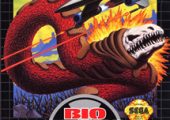
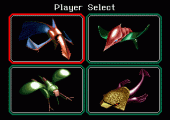
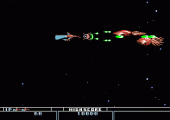
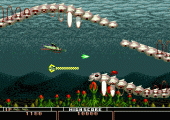
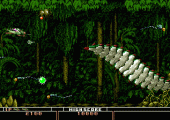
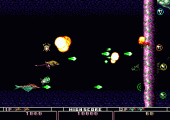
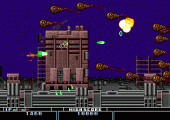
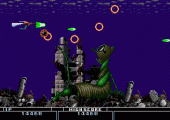
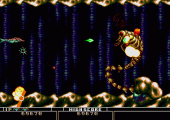
Biohazard Battle is Sega attempt to conquer the shmup’ monopoly of the Konami/Compile/Technosoft triad. More organic than any other game of the sort, the soft has great graphics and tough controls. A solid addition if not unforgettable by any way. CONCLUSION: 7/10
you mentioned Sunsoft being a dev of the fantasy zone series, but in the original fantasy zone, Sunsoft only ported the game for the Famicon. i have a feeling they don’t really contribute to the “story”, but are used to do the hard coding… the arcade original fantasy zone was mostly/all Sega. other companies with a dev hand in the original (be it port or arcade) were Bits Laboratory, GRC, Pixel. Sunsoft only has the right to say they did the work for Sega imo, not the right to claim the whole series. Sry, ik its a trivial matter but i kinda want to be a dev, and i wouldn’t appreciate if my work were over-credited to anyone, even myself. lol
I love this game. The music is fantastic and sounds great through my hi-fi setup.
A really unique shooter for the Genesis. Challenging but it is fun and the graphics looks good. Overall, it’s a good, solid shooter.
I just picked up a copy for $5 today at a local game store (about what it goes for on Ebay) and got a chance to play… This game is great! It might not be the crown jewel of Shmups for the Genesis, but it’s fun, has a really beautiful and unique art-style and isn’t ‘hardcore’ difficult as to prevent you from enjoying it. I played through the first 4 or so stages with a friend, and I have to say it’s a really good addition to the list of two-player simultaneous games for the Genesis.